TRANSFORMATION OF THE PUBLIC SERVICE THROUGH ESTABLISHMENT AND OPERATIONALIZATION OF SERVICE UNGANDA CENTRES (SUCs)
1. BACKGROUND
(a) Government of Uganda has over time implemented Reform Programmes aimed at improving service delivery.
(b) Although Government has registered considerable achievements, there is increased demand to focus Government reforms on Citizen-Centric Service delivery strategies. The aim is to:
(i) improve customer satisfaction, by delivering outcomes based on citizens’ needs, expectations and preferences, at a much less cost;
(ii) enhance Government visibility, accessibility and credibility in the eyes of the citizens of Uganda;
(iii) Fight Corruption; and
(iv) Implement provisions of the World Agenda-SDGs (2015); Vision 2040; NDP II2015/16-2019/20); NRM manifesto (2016-2021; and
(v) Implementation of the Policy Paper on the Transformation of Public Service (2011), which among other things highlighted establishment of One-Stop-Centers, as a major strategy of improving service delivery. The Concept of One-Stop-Center has been domesticated by using the named Service-Uganda Centers.
(c) Implementation of Service-Uganda-Centers (SUCs) in the Public Service require systematic structural and systems reforms; to create an improved service delivery system; capable of increasing accessibility to public services.
2. LEAD AGENCY IN INSTITUTIONAL REFORMS (STRUCTURAL AND SYSTEMS)
Ministry of Public Service is the lead Agency of this reform because it has the overall mandate of determining policies, structures and systems for the management of Public Service Institutions and human Resources.
3. PROBLEM ANALYSIS
(i) Currently, service delivery in Government Institutions is characterized by:
(a) Complicated and cumbersome service delivery systems;
(b) Overlapping and duplicated efforts by MDAs and LGs;
(c) Costly and Inaccessible Public services;
(ii) Government Service Delivery Processes are marred by:
(a) Lack of transparency;
(b) Difficulty in accessing and sharing relevant data and information;
(c) Ignorance (Citizens) of where to find the service.
(d) Long queues at service delivery centers;
(e) Corruption tendencies;
(f) Delayed response, low speed, none engagement of service recipients (Citizens);
(g) Mandates focused service with little regard to the service recipients
(iii) Government Sectors which provide services to the people work in silos, yet they belong to the same Government and serve the same range of clients. These un-coordinated movements between and within (MDAs) and (LGs) are costly and time wasting;
4. WHY SERVICE UGANDA?
(i) Service Uganda Centers (SUCs) will provide a platform where multiple public services will be offered to clients/customers; in just in “a single space” under “one roof”.
(ii) The Integrated Services Delivery model will facilitate:
(a) Harmonious co-existence and collaboration of Sectors, MDAs andLGs;
(b) Convenience of accessing Public Services under one roof;
(c) Simplified and user friendly service delivery Systems;
(d) Cross-jurisdictional service delivery without losing sight of different mandates;
(e) Out ward/client focused services;
(f) Increased accessibility, quicker response and affordable cost.
(iii) This model has yielded tremendous improvement is other Countries. Examples of best practicing Countries of OSC are: (a) Regionally-Kenya (Huduma), Rwanda Umuramo), Tanzania, and Zambia (b) internationally: US Service Ontario), Azerbaijan (ASAN Service), Estonia, etc
(iv) In Nationally URSB has implanted OSC successfully.
5. WHAT HAS BEEN DONE?
(i) A Concept Paper and an Implementation Strategy on establishment of One-Stop-Centers in the Public Service has been developed by MoPS;
(ii) A Cabinet Paper has been submitted to Cabinet for Approval;
(iii) MoPS has benchmarked best Practices on establishment of Integrated Public Service Delivery centers in Rwanda, Kenya, Azerbaijan and Estonia. MoPS is still working closely with the Republic of Estania and Azerbaijan to provide technical assistance on implementation of the reform;
(iv) Institutions that have championed One-Stop Shop service delivery in Uganda have been visited and consulted (URSB in partnership with UIA, KCCA, URA, NEMA, Commercial Banks);
(v) MoPS is working closely with key stakeholder such as MoFPED, LGs, MoICT, among others to acualise the reform
(vi) The Ministry has formed Coordination Committees at two levels:
(a) Ministerial Coordination Committee comprising of Directors, Heads of Departments and Units and Focal Point Officers (FPOs) from Departments which will be key prayers in the implementation of OSCs;
(b) Inter-ministerial Coordination Committee comprising of Focal Point Officers (FPOs) from different MDAs;
6. WAY FORWARD ON SUCs IN THE PUBLIC SERVICE
(i) Ministry of Public Service (MoPS) to:
(a) The strategy is to establish 16 Service Uganda Centers within 4 years (At central and Regional Sites);
(b) The Ministry has been running pilot centers at MoPS, Jinja, Kasese, Mbale and Entebbe MCs
(c) 2018/19 2 Regional Centers will be established in Kasese and Mbale Municipalities
(d) 2019/20 -2 Regional Centers will be established in Northern Uganda (Gulu, Lira) in addition to other 2 whose sites are yet to be identified
(e) The SUC at MoPS has been refurbished and will be commissioned early next year;
(f) MoPS has signed MOUs with Azerbaijan and Estania to provide technical support on implementation of the Reform;
7. CHALLEGES
(a) New concept-which needs continuous sensitization create awareness;
(b) Mandate focused Sectors-MoPS will identify allies and first Track the Implementation on the “First Come First Serve” Basis;




No comments, be the first one to comment !